The Sepsis Pathway aims to alert clinicians to a patient who has suspected or confirmed sepsis, and warns them when certain decisions or specific treatment activities do not take place in the defined time periods.
The pathway includes:
- Manual initiation of the Sepsis Pathway
- Notification events on the FirstNet Tracking Boards
- Pop up alerts to warn of decisions or treatment that has not been documented
Place a patient on the Sepsis Pathway
If you suspect your patient has sepsis, the pathway can be activated at triage on the Triage Form:

Or by clicking the Sepsis Bomb icon on the Tracking Board toolbar at any time during their presentation, and answering the same question

This places the Sepsis Bomb on the Tracking Board, and displays the active pathway on the ED Pathways, Guidelines and Protocols component on ED View

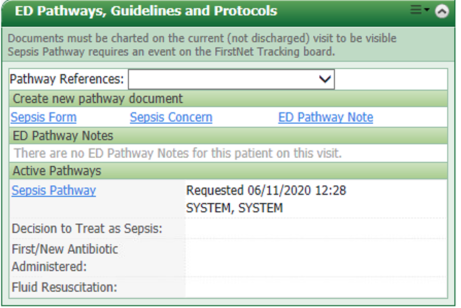
Pathway Alerts
On opening or closing the patient chart, different alerts will pop up, warning that decisions or treatment for sepsis are still due. There are different messages and actions in these alerts for medical or nursing staff
Decision to Treat as Sepsis
If the Decision to treat as sepsis (or not) has not been made, alerts will prompt medical staff to chart the decision on the Sepsis Form, or prompt nursing staff to engage medical staff. These alerts occur when the patient chart is opened (or closed for Medical staff)
The Decision to Treat as Sepsis is charted on the Sepsis Form, available from the central button on the Medical alert, in Ad Hoc, or from the ED Pathways, Guidelines and Protocols component.
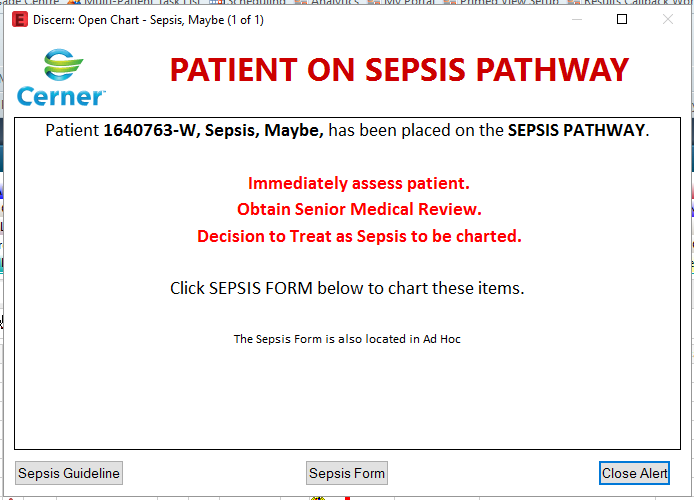
There are 3 options to choose as the Decision:

- Sepsis is definite or probable (with or without shock):
- This confirms the patient will be treated as septic and the pathway moves to monitor fluid and antibiotic orders.
- This confirms the patient will be treated as septic and the pathway moves to monitor fluid and antibiotic orders.
- Sepsis is possible (shock absent):
- This puts a pause on the requirement for a Decision for 90 minutes – no pop-up alerts will occur, unless the alerts for lactate and multiple bolus orders are triggered (see https://learning.schn.health.nsw.gov.au/ed-sepsis-digital-alerts )
- Escalation of the patient during this 90 minutes must be via communication to medical staff – there will be no further prompts for screening based on BTF results as the Sepsis Bomb remains on the Tracking Board until the decision is made
- During the 90 minutes, the decision can still be charted from the Sepsis Form in Ad Hoc, or from the ED Pathways, Guidelines and Protocols component.
- The option to chart Sepsis is Possible is only available once – when the 90 minutes has passed you cannot chart Possible again.
- No sepsis- remove from pathway:
- The Bomb is removed from the Tracking Board and there are no more alerts.
Decision to Not Treat as Sepsis
If the decision is to not treat the patient as having sepsis, chart this on the Sepsis Form, available from the central button on the Medical alert, in Ad Hoc, or from the ED Pathways, Guidelines and Protocols component. Charting the decision as NO deactivates the Sepsis Bomb from the Tracking Board and stops future alerts.
If the patient condition changes, the pathway can be reactivated by charting the Sepsis Concern again, from the Sepsis Bomb button on the Tracking Board toolbar, or from Ad Hoc.
Ordering of Antibiotics and Fluids
If the decision to treat as sepsis is YES, but fluids and antibiotics have not been ordered, alerts will highlight that.
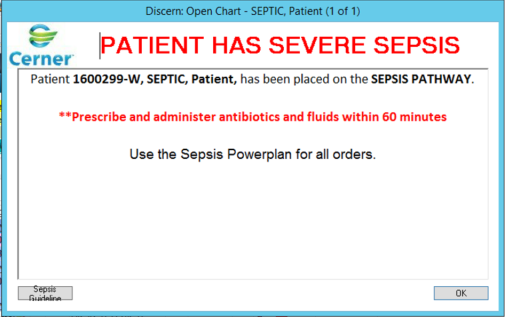
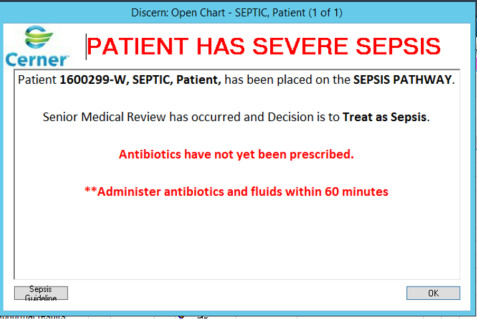
The Sepsis PowerPlan is recommended for ordering antibiotics and fluids, as well as diagnostic tests.
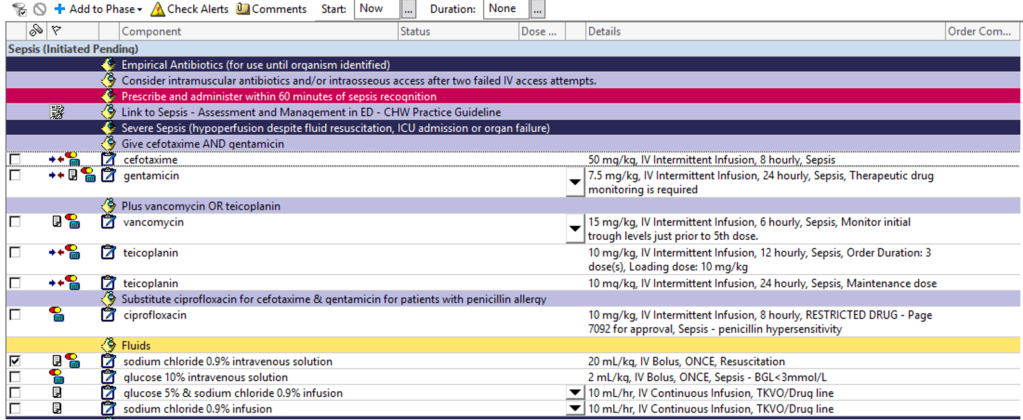
Antibiotics Are Ordered but Not Administered
If antibiotics have been ordered but not yet administered, pop up alerts on opening the chart will advise of this. The antibiotics that qualify are those from the Sepsis PowerPlan:
- Aciclovir
- Amoxicillin-clavulanate
- Ampicillin
- Benzylpenicillin
- Cefepime
- Cefotaxime
- Ceftriaxone
- Clindamycin
- Gentamicin
- Meropenem
- Piperacillin-tazobactam
- Teicoplanin
- Tobramycin
- Vancomycin
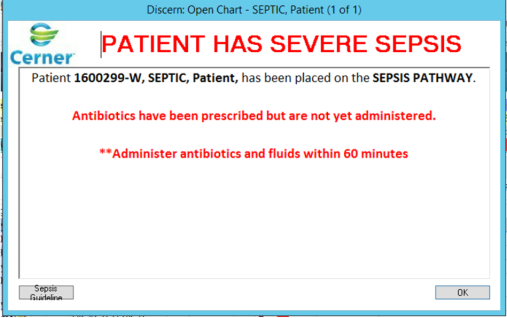
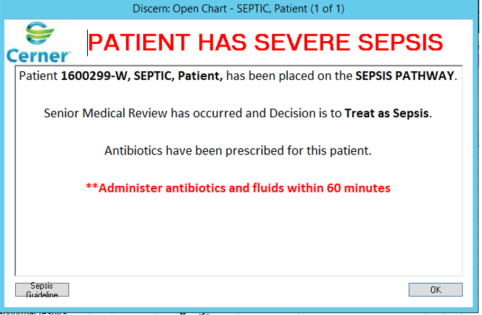
When antibiotics & fluids are administered, icons will appear in the Done/Complete column of the Tracking Board, and the ED Pathways, Guidelines and Protocols component will update with the date/time of administration.
Alerts do not track administration of fluids, as many types of fluid may be administered, including:
- Sodium chloride 0.9% intravenous solution (bolus)
- Hartmann's intravenous solution (bolus)
- Plasma-Lyte 148 electrolyte intravenous solution (bolus)


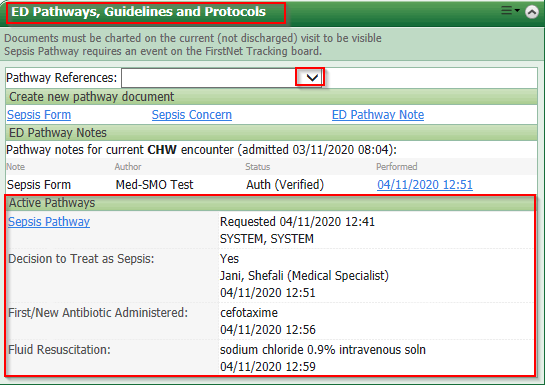
When the Sepsis Pathway is Activated in Error
If the patient is mistakenly placed on the Sepsis Pathway, click the Sepsis Bomb icon on the Tracking Board toolbar, and select the field The Sepsis Pathway was activated in error. This cancels the sepsis pathway and removes the Sepsis Bomb from the Pathways column

Note: Manually cancelling the Sepsis Bomb through ‘Set Events’ will not cancel the Sepsis Pathway.